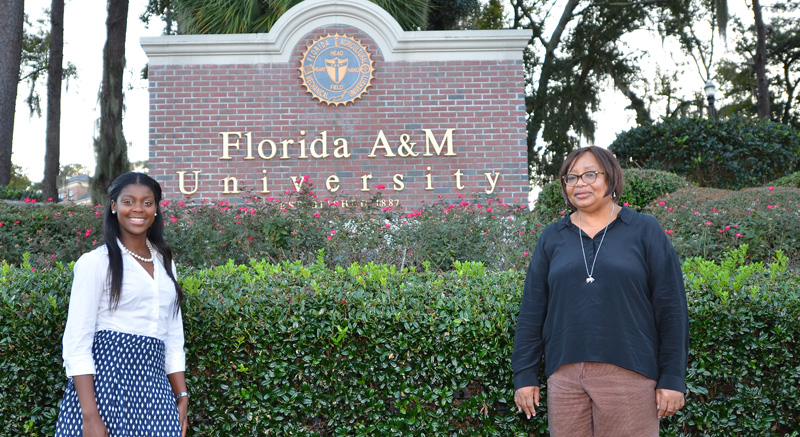 Tiffany McClary attended Palm Beach County, Florida public schools from grade school to high school. She excelled, but McClary who is black, says she never really felt like she belonged.
Tiffany McClary attended Palm Beach County, Florida public schools from grade school to high school. She excelled, but McClary who is black, says she never really felt like she belonged.
Today, McClary, a senior elementary education major at Florida A&M University (FAMU), says her Historically Black University makes her feel right at home. “After experiencing four years at Florida A&M University, and being taught by many teachers of color, I must say it feels better to be taught by your own,” McClary adds.
That’s an experience a growing number of students of color in the nation’s public schools don’t have and may never know. That’s because students of color make up almost half of the public school population, but teachers of color represent just 18 percent of the profession.
Recent data from the American Association of Colleges for Teacher Education point to a small pool of future educators of color in the pipeline: of the bachelor’s degrees awarded in 2013-2014, Black teacher candidates earned just 5 percent and Hispanic candidates 6 percent.
But if public schools are going to keep pace and meet the needs of the rising population of minority students, they will need to recruit more high-quality minority educators. Who teaches students of color matters, the research shows. When students have teachers who look like them and are more culturally responsive to their needs, they benefit academically and in other ways, too—they have fewer instances of absenteeism, suspension and expulsion, and higher test scores, levels of engagement, advanced-level course enrollment, graduation rates, and college enrollment. Also, teachers of color are more likely to work in urban and high-poverty schools and often feel it’s an important responsibility to fulfill.
As districts nationwide struggle to recruit teachers for underserved populations and for harder to fill teaching positions in math, science, and special education, (HBCUs and other minority serving institutions can be important resources. But understanding why more college and high school students aren’t drawn to the teaching profession in the first place, may be the first step.
Elizabeth Davenport, Ph.D., J.D., a FAMU College of Education professor, points to several reasons more students of color aren’t joining the ranks of educators. Their own negative school experiences are among them.
When North Carolina A&T researchers surveyed high-achieving, African-American male high school students about whether they would make teaching their chosen career, they found that students’ prior negative experience with teachers could be a stumbling block.
They are not alone, Davenport says. “If you had a bad experience, the very last thing you’ll pursue is a career that would put you back in a classroom. “I think a lot of African-American students feel disenfranchised, especially Black males.”
 Tiffany McClary, FAMU Student Florida Education Association President , and Elizabeth Davenport, FAMU Professor of Education.
Tiffany McClary, FAMU Student Florida Education Association President , and Elizabeth Davenport, FAMU Professor of Education.
Find Ways to Raise the Status of the Profession
She also thinks many high-achieving students today are encouraged to pursue high status careers that pay well.
There was a time, Davenport says, when “education was the middle class profession for African Americans and minorities, but now other professions, like medicine and law, are very much part of our middle class foundation and students are directed out of teaching.” And as a result, “teaching has gotten a bad name” and their profession, little respect, Davenport adds.
Even Davenport was discouraged from pursuing a teaching career at the University of Michigan. She’d been president of Future Teachers of America for three consecutive years, but was told that “smart” girls don’t become teachers. So Davenport went to law school. Eventually she returned to education, but that early message was clear: there were more prestigious careers than teaching.
Chelsey Herrig, chair of the NEA-Student Program, agrees that this narrative of public school teachers needs to change.
“We need to be viewed as professionals with a high-quality set of unique skills,” Herrig says.
Remove Financial Barriers
But even if the education profession was considered more prestigious and attractive to students, an even bigger barrier to recruitment is the low earning potential of teachers combined with high student debt.
All teachers grapple with salary challenges, but teachers of color are more likely to teach in public schools in urban, high-poverty communities where school budgets are the tightest. Data from the 2011-2012 National Center for Education Statistics’ Schools and Staffing Survey show that teacher salaries in high-poverty districts lag behind those of teachers in well-resourced districts, with gaps sometimes as wide as $16,000 a year.
Students of color often have more debt as well. A 2010 College Board Advocacy & Policy Center study found that 27 percent of African-American bachelor’s degree recipients carried $30,500 or more in debt, compared with 16 percent of white undergraduates.
“It’s hard to attract someone to teaching when they have high student loans and debt,” Davenport says. “M any people can’t afford to go into teaching.”
A new program for pre-service teachers at Norfolk State University, an HBCU in Norfolk, Va. , could be part of the solution. With a $1.1 million grant from the U.S Department of Education, Norfolk State has attracted 140 teacher candidates who receive mentoring, tutoring, financial literacy and help with test-taking skills. The grant, aimed at producing high-quality teachers, will also pay for professional tests and organization fees.
Partner with Community Colleges
Education programs should also offer seamless connections with local community colleges – which many students of color attend because of their affordability -- so that potential education majors can transition more easily, Davenport suggests. If more community colleges offered two-year associate programs in partnership with local four-year colleges and universities, more students could transfer those credits to receive a bachelor’s degree in education.
For example, Houston Community College offers an Associate of Arts in Teaching, a state-approved collegiate degree program intended for transfer to baccalaureate programs that lead to initial Texas teacher certification. Lorain County Community College in Elyria, Ohio, offers an Associate of Arts in Teacher Education or Associate of Applied Science in Early Childhood Education, both of which transfer easily to Ohio’s four year colleges and universities.
Retention is Critical
How to increase retention rates of teachers of color may not be the biggest concern facing school districts, Herrig suggests. Instead, she says, attracting the right people to the profession should be the focus.
During the 2008-09 school year, more than 19 percent of teachers of color changed schools or left the profession, compared to 15.6 percent of white teachers, mainly because of low salary combined with difficult working conditions. Of those teachers of color who did leave the classroom, were dissatisfied and sought new careers, the research shows..
In their 2015 study, the Center for American Progress called the retention problem a “leaky pipeline.” Stopping the leak, they said could be fixed with things like monetary incentives, and professional development to ensure that the best and brightest students of color enter teaching and succeed once in the profession.
“If we retained more of the [diverse] educators within their first 3-5 years in the classroom, the shortage would be less of an issue,” says Herrig. “Think of this situation as a bucket with a hole. Right now, we have a giant hole in our bucket.”





